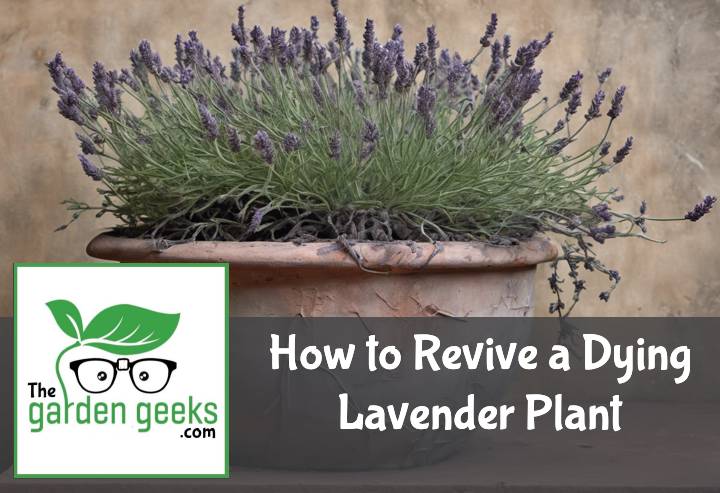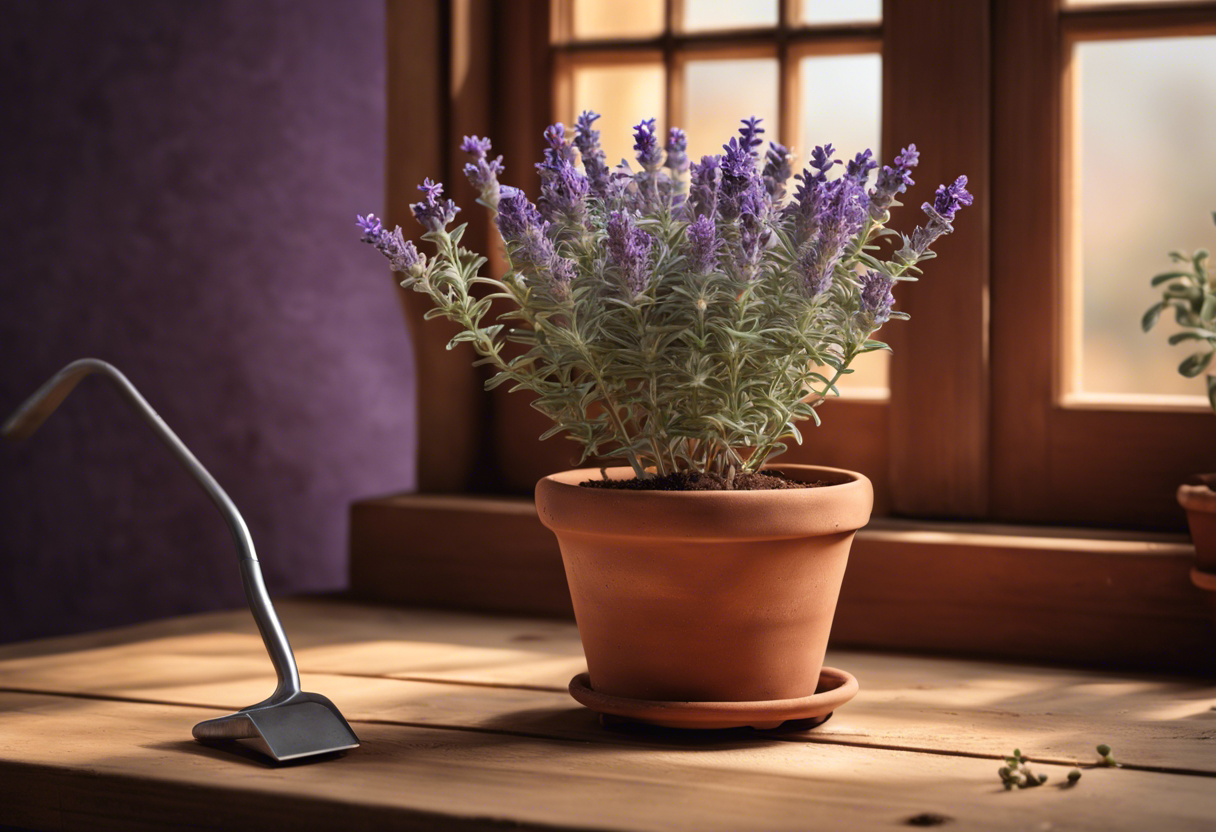Remember that time when you excitedly brought home a beautiful lavender plant, dreaming of its soothing scent wafting through your home? But alas, the poor thing seems to be on its last legs now. Don’t fret! If you’re wondering How to Revive a Dying Lavender Plant, you’ve come to the right place.
In this blog post, we’ll embark on a rescue mission together. We’ll diagnose the problem, explore some life-saving techniques, and ensure your lavender plant bounces back in full bloom. So buckle up green thumbs, let’s bring your lavender back from the brink! Keep reading about How to Revive a Dying Lavender Plant.
Key Takeaways
- Identify the problem with your lavender plant: overwatering, poor soil drainage, or lack of sunlight.
- Correct watering: Lavender plants need less water than most. Allow soil to dry out between watering.
- Improve soil drainage: Use a well-draining soil mix and consider adding sand or small rocks.
- Ensure adequate sunlight: Lavender needs full sun exposure for at least 6 hours daily.
- Prune properly: Remove dead flowers and trim back approximately one-third of the plant after blooming season.
Understanding Lavender Plant Health
When it comes to how to revive a dying lavender plant, understanding the health of your lavender is crucial. It’s like being a plant doctor, diagnosing what’s causing your lavender to feel under the weather.
Identifying Signs of a Dying Lavender Plant
So, how do you know if your lavender is in trouble? Well, there are some tell-tale signs. Look out for discoloration or wilting. These are classic symptoms of dying lavender. If your once vibrant purple blooms are looking pale and lifeless, it might be time for some serious lavender plant care.
Another sign could be that the leaves are turning yellow or brown. This isn’t just an autumn fashion statement from your plant; it’s a cry for help! And if your lavender looks more like a dried-up tumbleweed than a flourishing bush, then you’ve got yourself a wilting lavender plant on your hands.
Common Causes of Lavender Plant Decline
Now let’s talk about why this might be happening. One common culprit is overwatering. Yes, plants need water to survive but drenching them like they’re competing in a wet t-shirt contest isn’t going to do them any favors.
Another reason could be pests. Those little critters can cause havoc on your lavenders, munching away at their leaves and stems. So if you notice any unwanted guests, it’s time to show them the door!
Remember folks, understanding the reasons for lavender decline is half the battle won in learning how to revive a dying lavender plant!
Assessing Your Lavender Plant’s Environment
When it comes to how to revive a dying lavender plant, the first step is understanding your plant’s environment. This includes evaluating soil conditions, light and temperature requirements, and watering practices. All these factors play a significant role in lavender plant care.
Evaluating Soil Conditions
Now, let’s talk dirt! Lavenders are pretty picky about their soil. They prefer well-drained soil with a pH level between 6.5 and 7.5. So, if you’ve got clay or heavy soil, your lavender might be throwing a tantrum.
To assess the quality of your soil, you can use a simple pH test kit from any garden store. If the pH is off or drainage is poor, don’t panic! You can improve the situation by adding some organic matter or sand to lighten up the texture. Remember, when it comes to improving soil for lavenders, it’s all about balance!
Checking Light and Temperature Requirements
Next on our checklist is light and temperature. Lavenders love sunbathing – they need at least six hours of sunlight each day! If your lavender is stuck indoors without enough light, it might start feeling gloomy.
Ideal temperatures for these plants range between 60°F (15°C) and 70°F (21°C). Too hot or too cold can stress out your plant causing it to wilt or even die. So keep an eye on those temps!
If you’re growing lavenders indoors, make sure they’re near a sunny window or under suitable indoor lighting. Trust me; nothing perks up a lavender like some good ol’ sunshine!
Reviewing Watering Practices
Finally, let’s talk water – because yes, there is such thing as loving your plant too much! Overwatering is one of the most common causes of lavender demise.
Lavenders are native to the Mediterranean region, which means they’re used to dry conditions. If your lavender’s leaves are turning yellow or brown, it might be a sign of overwatering.
On the flip side, underwatering can also harm your plant. If the leaves are wilting or dropping, it might be time to up your watering game.
Remember, when it comes to watering lavender plants correctly, consistency is key! So keep a close eye on your plant and adjust your watering schedule as needed.
Reviving Techniques for a Dying Lavender Plant
When it comes to how to revive a dying lavender plant, there are several techniques that can be employed. These include adjusting soil composition, modifying light and temperature exposure, and altering watering frequency. Each of these factors plays a crucial role in lavender plant care and can significantly aid in reviving dying plants.
Adjusting Soil Composition and Drainage
First off, let’s talk about the dirt under your green thumb. The right soil composition for lavender is essential for its survival. Lavenders love well-drained soil with neutral to slightly alkaline pH levels. So, if your lavender is looking a bit under the weather, consider adjusting soil pH or adding some grit to improve drainage.
But wait! There’s more! You also need to ensure that your lavender isn’t sitting in waterlogged soil. Overly moist conditions can lead to root rot – a death sentence for any plant. Therefore, enhancing soil drainage is another key step in our mission of lavender revival.
Modifying Light and Temperature Exposure
Next up on our list of lavender revival techniques is tweaking light and temperature conditions. Lavenders are sun-lovers; they thrive in full sun exposure. If your plant isn’t getting enough rays, it might be time to move it somewhere brighter.
On the flip side, lavenders aren’t fans of extreme heat or cold either. They prefer temperatures between 60-70°F during the day and 50-55°F at night. So remember folks, when it comes to reviving your lavender with light and temperature control – balance is key!
Altering Watering Frequency and Amount
Last but not least on our journey of how to revive a dying lavender plant is watering habits. Lavenders are drought-tolerant plants that don’t take kindly to overwatering. So if your lavender is looking a little droopy, it might be time to alter your watering schedule.
Remember, the ideal watering amount for plants like lavender is enough to keep the soil moist but not waterlogged. So, cut back on the H2O and let the soil dry out between waterings. With these changes in place, you’ll be well on your way to reviving your lavender with water changes.
Disease and Pest Control for Lavender Plants
When it comes to how to revive a dying lavender plant, disease and pest control play a significant role. It’s like the health insurance for your plants, keeping them safe from common diseases and pesky pests.
Recognizing Common Diseases in Lavender Plants
One of the first steps in lavender plant care is recognizing signs of disease. Like humans, plants also show symptoms when they’re not feeling well. For instance, if your lavender starts looking more grey than purple, it might be dealing with a case of fungal infection.
The effects of diseases on lavenders can be quite dramatic, often leading to wilting or discoloration. So keep an eye out for any changes that seem out of the ordinary. Remember, early detection is key in preventing further damage!
Implementing Organic Pest Control Methods
Now let’s talk about bugs – not the cute ones, but those pesky critters that love munching on your lavender plants! Implementing organic pest control methods can help keep these unwanted guests at bay.
There are plenty of natural remedies for pests available that won’t harm your lavenders or the environment. From homemade sprays using household items like garlic and chili powder to introducing beneficial insects into your garden – there’s an organic solution for every lavender pest.
Remember, safe pest control methods are not only better for your plants but also for our planet! So next time you spot a bug on your lavender, don’t reach for the chemical spray; try an organic approach instead.
Long-Term Care Strategies for Healthy Lavender Plants
When it comes to lavender plant care, it’s not just about how to revive a dying lavender plant. It’s also about maintaining the health of your lavender in the long run. This is where long-term lavender strategies come into play, with regular pruning and seasonal fertilization being key.
Regular Pruning Practices
Now, you might be wondering why we’re talking about pruning when we’re supposed to be discussing how to keep your lavender alive and kicking. Well, pruning lavender plants isn’t just for aesthetics. It’s actually one of the best ways to maintain their health.
Pruning encourages new growth and helps prevent disease by improving air circulation within the plant. So, if you want your lavenders to live long and prosper, get those pruning shears ready!
The question now is, when should you prune? The best time would be after flowering, usually in late summer or early fall. But remember – don’t go too crazy with the shears! A gentle trim will do just fine.
Seasonal Fertilization Tips
Moving on to fertilization – another crucial part of maintaining lavender health. You see, lavenders are pretty low-maintenance plants but they do appreciate a little extra TLC during certain times of the year.
Fertilizing your lavenders can give them that extra boost they need to grow strong and healthy. But timing is everything! The best time for fertilization is in the spring when new growth begins.
As for what type of fertilizer to use, well that depends on your soil. If it’s rich in organic matter, a general-purpose fertilizer should do the trick. If not, you might want to consider using a slow-release granular fertilizer specifically designed for lavenders.
So there you have it folks – some handy tips on how to keep your lavenders happy and healthy in the long run. Remember, a little care goes a long way!
To Wrap Up
Like a superhero nurse, you’ve now got the know-how to swoop in and save your wilting lavender from the brink of doom! Remember, it’s all about the right balance of sun, water, and soil.
So why wait? Jump into action and put these tips from How to Revive a Dying Lavender Plant to use. Your lavender will thank you with vibrant blooms and heavenly scent!





